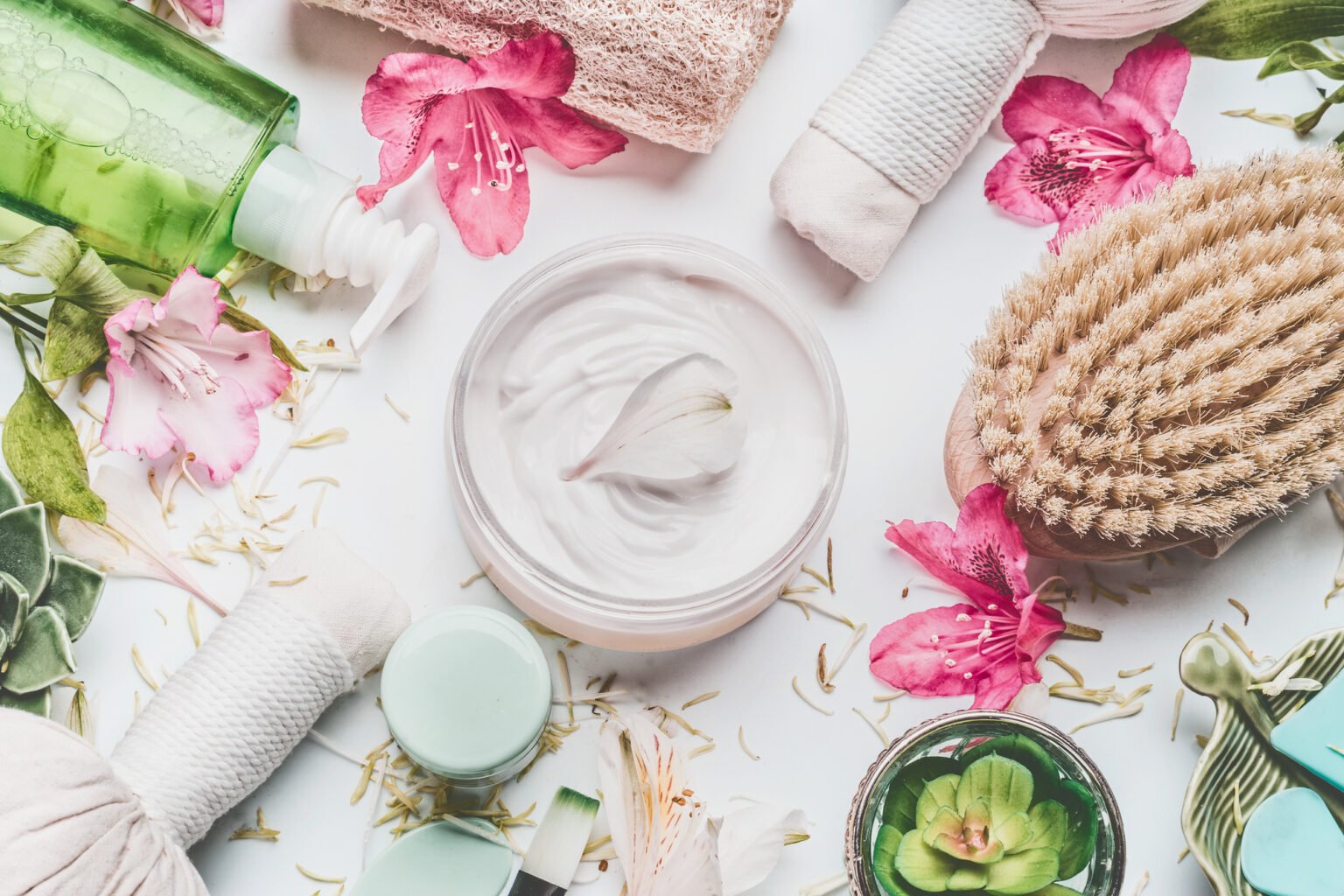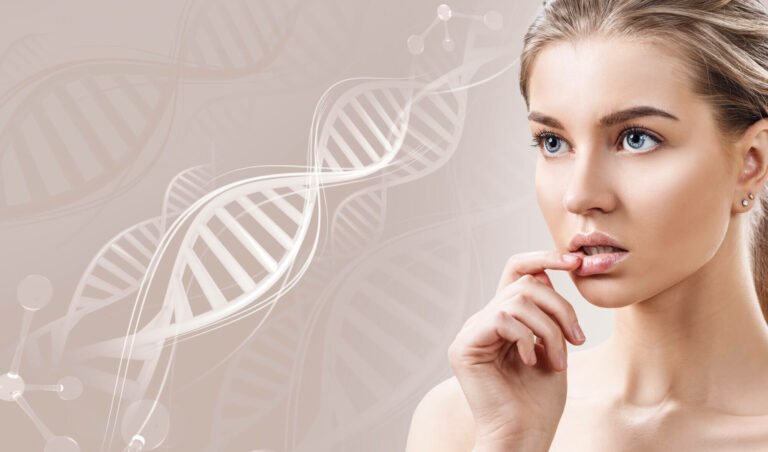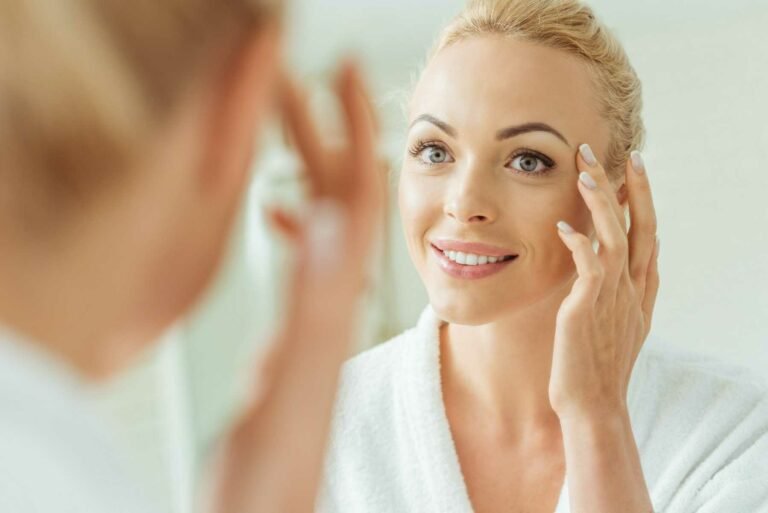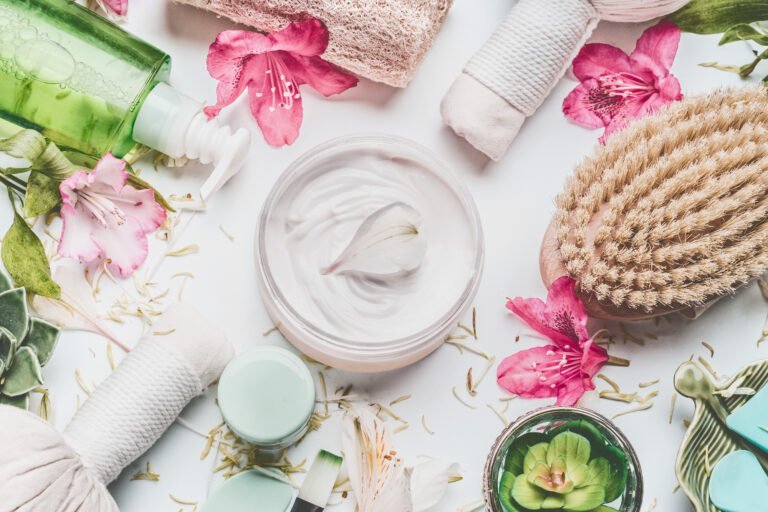Toxic Skincare Ingredients to Avoid and What to Include

Table of Contents
Did you know that, on average, a woman uses around 16 skincare products daily? Most people assume that the ingredients in each product have been thoroughly tested to ensure that they’re safe. Unfortunately, that’s not always the case.
Most skincare products are tested to ensure they don’t cause short-term problems. Skincare ingredients aren’t checked to see if they result in long-term issues. Knowing which ingredients in skincare products are harmful to your health is essential.
This guide will discuss the top ingredients to avoid in skincare. We’ll also discuss the best skin ingredients to look out for when purchasing new products.
Harmful Skincare Ingredients to Avoid
The United States has banned only 11 skincare ingredients. The European Union has restricted or outlawed over 1,300 ingredients.
In the United States, the skincare ingredient laws haven’t gotten updated since 1938. Women expose themselves to countless harmful ingredients through their multiple skincare products.
Remember that cosmetics don’t have to undergo a pre-approval process before hitting the shelves. The Food and Drug Administration (FDA) isn’t required to test the effectiveness and safety of a skincare product.
You can avoid harmful ingredients by reading the labels on the products before using them. Let’s discuss some of the most common skincare ingredients you’ll want to avoid.
Parabens
Parabens are a commonly used ingredient found in many skincare and cosmetic products. It’s used as an artificial preservative. The chemical is added to reduce and prevent mold and bacteria from growing.
According to the EWG, it’s thought that parabens can disrupt your body’s hormones. That’s because they’re endocrine disruptors. It could also do the following:
- Harm your reproductive organs
- Increase your cancer risk
- Affect your birth outcomes
- Cause skin irritation
Parabens are still widely used despite these allegations. They’re typically found in the following products:
- Toothpaste
- Shaving gel
- Deodorant
- Sunscreen
- Face cleansers
- Moisturizers
- Conditioners
- Shampoos
Parabens get absorbed into your body through your skin. The parabens then get metabolized and excreted through your bile and urine.
Using multiple products daily that contain parabens can increase your exposure to them.
A product won’t always list “parabens” on the ingredients. Keep your eye out for the following ingredients:
- Methylparaben
- Polyparaben
- Isobutyl paraben
- Propylparaben
- Butylparaben
Petroleum Jelly
Another skincare ingredient to avoid is petroleum jelly. Petroleum jelly is typically found in lotions. Its primary function is to be a moisturizing agent.
If petroleum oil is refined correctly, it’s not harmful to our health. Unfortunately, petroleum oil doesn’t always get refined correctly in the United States. When it’s not refined correctly, it might result in polycyclic aromatic hydrocarbons (PAHs).
According to the CDC, PAHs are chemicals that you can naturally find in gasoline, crude oil, and coal. Petroleum jelly can easily absorb into our skin. As it gets absorbed, it locks itself between our cells in our skin’s lipid barrier.
While petroleum jelly is commonly used as a moisturizing agent, it doesn’t have any moisturizing properties. Instead, it forms a barrier between the elements and our skin. It can lock in the moisture underneath it, giving you the appearance of moisturized skin.
Unfortunately, it can also lock in sweat, bacteria, or dirt on your skin. The barrier can deter beneficial ingredients and additional moisture from reaching your skin. Petroleum jelly is not water soluble, so you can’t easily wash it away.
Oxybenzone
You’ll usually find oxybenzone in sunscreens. According to Made Safe, oxybenzone is linked to the following health concerns:
- Contact allergies
- Endocrine disruption
- Organ system toxicity
It’s also been linked to photoallergies. Photoallergies refer to an allergic response that requires a certain amount of light exposure.
Oxybenzone is also harmful to aquatic life. Hawaii banned the selling of sunscreens that contain the chemical in 2021.
A study determined that oxybenzone bleaches the coral reefs, depriving them of their nutrients. Oxybenzone can also disrupt the development of various wildlife, such as fish. Even a tiny drop of the chemical can damage delicate coral reefs.
Phthalates
Phthalates can be found in various cosmetic products, such as nail polishes and fragranced lotions. Phthalates are chemicals that make plastics challenging to break and more flexible. This chemical can damage the lungs, kidneys, reproductive systems, and liver.
Phthalates come in a few forms when used in cosmetic products:
- Dimethyl Phthalate (DMP): Used in products like hair sprays, so the hair stays flexible
- Dibutyl Phthalate (DBP): Used in nail polish, so the polish doesn’t get brittle
- Diethyl Phthalate (DEP): Used as a fixative and solvent in fragrances
DBP and DMP aren’t used as commonly in cosmetic products as they once were. DEP is the only one that’s still used in cosmetic products.
Formaldehyde
Formaldehyde is commonly used in skincare products, like baby soaps and shampoos. The chemical is used to prevent the growth of microbes in water-based products.
Formaldehyde is a strong-smelling and colorless gas used in other products besides cosmetics. It’s commonly used in building materials and walls. Formaldehyde is also a known carcinogen.
If the chemical gets absorbed through the skin, it can result in allergic reactions and cancer. Some of the products that you can commonly find formaldehyde in are:
- Hair gel
- Nail glue and polish
- Eyelash glue
- Color cosmetics
- Baby soap and shampoo
When formaldehyde is a skin care product ingredient, a person can get exposed to it by inhaling the chemical that gets off-gassed by the product. They can also ingest the formaldehyde or absorb it through their skin.
Coal Tar
Coal tar isn’t an ingredient that you’d think would be commonly found in skincare and cosmetic products. Coal tar comes from coal. It’s a solid fuel that contains coal gas and carbon.
Coal tar is typically used for producing coal-tar products and refined chemicals, like coal-tar pitch and creosote. It’s also been used to treat skin conditions like dandruff, psoriasis, and eczema. You can find coal tar in anti-dandruff shampoos and hair dyes.
People can inhale, ingest, or absorb coal tar through their skin. It’s been known to cause the following problems:
- Skin tumors
- Neurological damage
- Digestive tract, lung, and kidney cancer
Carbon Black
The FDA banned carbon black, but it’s still found in some cosmetic and skincare products. It’s a black powder that’s used to color different products. Some of the types of products it’s used in include:
- Eyelash glue
- Mascara
- Eyeliner
Exposure to carbon black can cause various health issues. These health problems include disrupting your lung functions and increasing your cancer risk.
You should keep an eye out for products that contain the following ingredients:
- Furnace black
- D&C Black No. 2
- Thermal black
- Lamp black
- Channel black
Fragrance
Artificial fragrances are one of the most harmful ingredients in skincare and personal care products. You should avoid products that have the following word on their label:
- Perfume
- Fragrance
- Parfum
The fragrance is known as a “cluster ingredient.” The fragrance can include up to 4,000 different chemicals, and you won’t know which one is in your product. The chemicals included in a product’s fragrance don’t have to be disclosed because of intellectual property or proprietary interest.
Fragrance formulas have been linked to allergic reactions. They can also cause various skin and respiratory conditions. Around 35% of people have reported migraines because of skincare products with fragrances.
Artificial Colorants
Dyes get added to skincare and cosmetic products to alter their color. Unfortunately, these additives can result in unwanted redness, irritation, and inflammation of your skin.
Artificial dyes can also irritate your skin if you’re prone to acne. They can clog your pores, changing your skin’s natural oil balance. As your pores get blocked, your chance of pimples will increase.
Artificial colors might contain ingredients that are harmful to your health, like the coal tar we mentioned earlier. If artificial colorants are purchased from untrustworthy sources, they might have other toxic substances. The substances could be arsenic or lead.
Remember that your body won’t absorb enough of the ingredient to be dangerous. However, it could cause skin irritation and other problems.
Most skincare products will list the colors on their ingredients. For example, it could say “colorant” or “yellow 6.” Avoid products that list anything like that on the label.
Sodium Lauryl Sulfate
Sodium lauryl sulfate is a “surfactant.” It decreases the surface tensions between the ingredients in a product. It’s typically used as a foaming and cleansing agent.
What’s concerning about sodium lauryl sulfate is that it’s found in skincare and household cleaning products. You can find it in skincare and beauty products like shampoos, body washes, and face cleaners.
Sodium lauryl sulfate can result in various problems. These issues include:
- Stripping hair dye from your hair
- Causing an allergic reaction
- Skin irritation
Sodium lauryl sulfate can also increase the presence of canker sores on your lips and mouth.
Alcohol
Methanol, isopropanol, and ethanol are the types of alcohols that typically appear in skincare products. Alcohols tend to cause significant reactions to your skin and irritate it. You might think that your skin looks great after using an alcohol-based skincare product, but it will have long-term adverse effects.
Alcohol dries out your skin, damaging its protective barrier. It can also disrupt how your skin replenishes and renews itself.
Many alcohol-based products are advertised as decreasing oiliness. Over time, those skin care products will have the opposite effect on your skin. As the alcohol dries your skin out, it’ll start producing more oil to compensate.
Certain fatty alcohols can provide you with benefits without irritating your skin. Small amounts of these products are great for any skin type. Look for these ingredients on a product’s label:
- Cetearyl
- Stearyl
- Cetyl
- Lanolin
You’ll want to look for products that decrease oiliness, increase hydration, and improve your skin tone.
What Are the Best Skincare Ingredients?
Knowing how many harmful skincare ingredients are regularly used in products can be overwhelming. It’s just as important to know what skincare ingredients to include in your products as it is to know which ones to avoid. Let’s go over the best skincare ingredients you should ensure are in the products you buy.
Hyaluronic Acid
Hyaluronic acid is a substance that’s naturally found in our bodies. You can find hyaluronic acid in the fluids in our joints and eyes. It serves as a lubricant and cushion between our joints and tissues.
Hyaluronic acid comes in different forms that are used in cosmetic products. It’s effective for improving the moisture in your skin because it holds large quantities of water. It also prevents moisture from evaporating while helping your skin retain it.
Look for moisturizing skincare products that contain hyaluronic acid. It works well for both dry and oily skin types. A hyaluronic acid serum will help boost your skin during the dry and colder months.
Retinol
Retinol is a derivative of vitamin A. It’s an effective ingredient that’s safe for all skin types. Retinol is a widely used compound that might reduce wrinkles and fine lines.
Retinoids function by increasing collagen production in your skin. Additionally, they’ll stimulate new blood vessel production in your skin. The production of new blood vessels will improve your skin’s color.
Retinol will also soften rough patches on your skin and help fade age spots. Retinol also works like an antioxidant, addressing the free-radical damage in your skin.
You can purchase skincare products that include retinol as one of their ingredients. You can also buy retinol as a serum and apply it directly to your skin.
Keep in mind that using retinol might result in skin dryness. You should start by using the product every other day before working up to a nightly application.
You should also wear sunscreen during the day. Retinoids will increase how sensitive your skin is to sunlight.
Alpha-Hydroxy Acids (AHAs)
Alpha-hydroxy acids (AHAs) are a collection of animal and plant-derived acids in various skincare products. Seven different forms of AHAs are typically used in skincare products. They include:
- Glycolic acid
- Citric acid
- Lactic acid
- Hydroxycaprylic acid
- Malic acid
- Hydroxycaproic acid
- Tartaric acid
Of all the common AHAs, lactic and glycolic acid are the least likely to cause skin irritation. Most of the over-the-counter skincare products you can purchase contain either of these AHAs.
Lactic acid comes from milk, and glycolic acid gets derived from sugar cane. The acids work to slough off your dead skin cells, revealing new skin underneath.
AHAs provide you with various benefits. These benefits include:
- Prevention of acne breakouts
- Brightening of complexion
- Increased blood flow
- Improved collagen production
- Increased product absorption
- Improved appearance of fine lines and wrinkles
AHAs also function as humectants. They can draw water from your environment, putting it into your skin.
Ceramides
Imagine that your skin cells are bricks. Ceramides function as the mortar holding the bricks together. Ceramides are long chain fats that hold your skin cells together, keeping irritants and allergens out.
Unfortunately, as we age, our ceramide levels decrease. It’s essential to add ceramides to your skincare routine, so your skin stays smooth and supple.
Ceramides create a barrier in your skin that prevents moisture loss. Some additional benefits of ceramides include:
- Increased skin hydration
- Aging skin rejuvenation
- Protection against UV damage
Skincare products contain synthetic ceramides, but they can also be found naturally in certain foods, like rice and sweet potatoes. Ceramides are typically found in the following types of skincare products:
- Toners
- Serums
- Cleaners
- Moisturizers
You’ll usually see Ceramides 2 and 3 listed as ingredients on products for your neck and face. You might also see it listed as ceramide EOP, ceramide NG, or ceramide AP.
Sphingosine might be listed as well. That’s the organic chemical compound that’s involved in creating ceramides.
Vitamin C
Vitamin C is great for all aspects of your body. It’s an antioxidant. That means it fights against harmful free radicals from air pollution on your skin.
Free radicals can harm your skin. Topically applying vitamin C can help your body fight against them. It can also improve your skin’s appearance.
The antioxidants contained in vitamin C can also protect your skin from UV rays. You can use vitamin C and a safe sunscreen to help protect you from sunlight.
Skincare products that contain vitamin C might also help lighten dark spots on your face. Vitamin C can also smooth fine lines and wrinkles on your face and neck. Consuming more foods that contain vitamin C can help that as well.
Vitamin C can also boost collagen production, improving skin elasticity. It can also maintain the collagen already present in your skin. It can protect it from becoming damaged.
Niacinamide
Niacinamide is a form of vitamin B3. Vitamin B3 is an essential nutrient for our bodies. Being deficient in vitamin B3 can cause problems with our kidneys and skin.
Applying niacinamide to your skin will work to address your skin concerns. You can look for serums, creams, and cleaners that contain the ingredient. Some face masks also include niacinamide.
Niacinamide provides your skin with various benefits. These benefits include:
- Improve your ceramide levels
- Build keratin in your skin, keeping it healthy and firm
- Reduce the appearance of pores
- Minimize blotchiness, redness, and inflammation
- Regulate how much oil your sebaceous glands create
- Rebuilds healthy skin cells
- Lightens dark spots
- Reduces the appearance of wrinkles and fine lines
- Helps treat acne
When purchasing a skincare product containing niacinamide, you should look for products with around 5% of the ingredient. For those with sensitive skin, you might want to try a lower concentration at first. Niacinamide might be listed as “nicotinamide” or “niacin” on ingredient lists.
Vitamin E
There are around eight different forms of vitamin E. Vitamin E refers to a group of oil-soluble antioxidants. Tocopherol and tocopherol acetate are the two you’ll usually find in skincare products. Since it’s an antioxidant, it’s effective at fighting free radicals and protecting your skin from them.
Our levels of vitamin E tend to lower as we age. Sun exposure and UV light can also reduce vitamin E levels in your skin. Applying vitamin E topically to your skin is a great way to boost your levels.
Topical vitamin E products are available in oil and cream form. It’s also added to eye serums, sunscreens, and anti-aging creams.
It’s easy for vitamin E to absorb into your skin. Using vitamin E topically might increase how much of the nutrient you have stored in your sebaceous glands.
Some of the benefits of vitamin E include:
- Widening your blood vessels
- Reducing the symptoms of dermatitis
Algae Extracts
Algae might be a surprising ingredient to include in skincare products. Various types of algae include antioxidant and anti-inflammatory properties.
Algae extracts can provide you with numerous benefits. Some of the benefits include:
- Increasing moisturization
- Maintaining your collagen levels
- Improving hyperpigmentation
- Reducing inflammation
- Treating various skin conditions
Red algae are great for boosting the amount of moisture in your skin. It can create a 128% moisture surge with just a single application.
Spirulina is another algae extract. It has cleansing properties. It can also help your skin stay moisturized and smooth.
Astaxanthin comes from red microalgae. It’s more potent than vitamin E and C, making it a powerful antioxidant. It also helps to reduce the appearance of wrinkles on your skin.
Green and brown algae have high amounts of vitamin C. Chlorella is a green microalgae that includes high levels of zinc, magnesium, and B vitamins. Those nutrients are excellent for detoxing your skin.
Learn More About the Best Skincare Ingredients for Your Body
Once you know what skincare ingredients to avoid, you can begin making educated decisions regarding your skincare routine. Find high-quality products that contain safe ingredients that will naturally boost your skin.
Ingredient Secret‘s products are designed to combat skin aging from the inside out. We use the best skincare ingredients that are safe and healthy for your skin. Shop our online store to see our full range of products.


